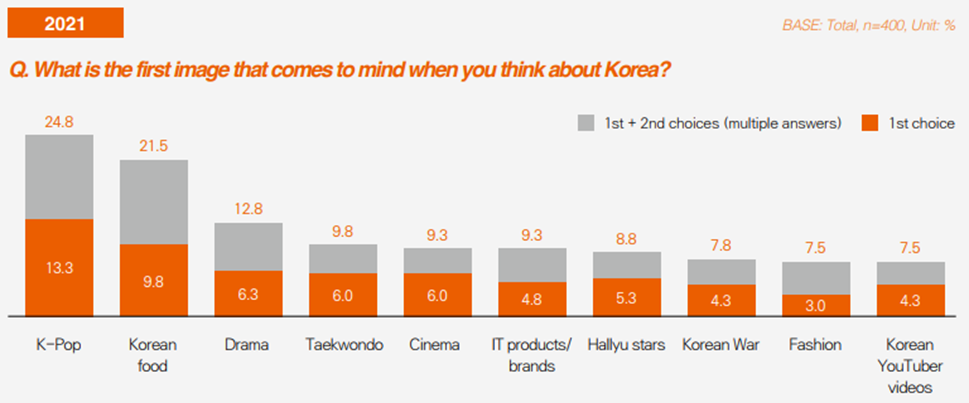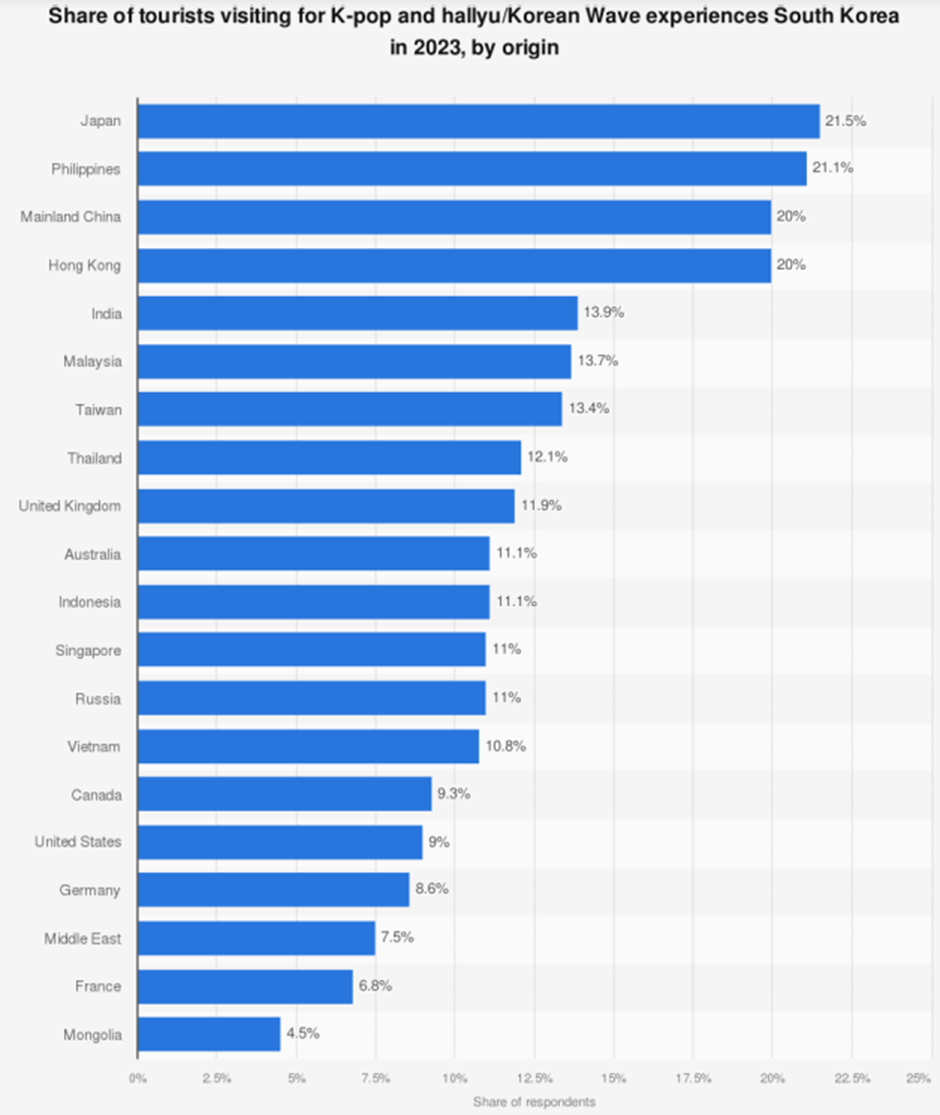[한류] Riding the Korean Wave: The Growing Impact of Hallyu on Australian Culture and Society (호주에서의 한류 인기 증가의 효과)
Hallyu in Australia is gaining traction but remains relatively weak compared to other regions. Limited academic research highlights gaps in understanding its impact. While K-pop is the most popular aspect, growing interest in Korean food and culture.
Author:
Chloe Miller and Eun Sam Cho | Master's course at Seoul National University
K-pop idols, K-dramas, and kimchi – the phenomenon of Hallyu, or the Korean Wave, has been making waves worldwide, and Australia is starting to feel the splash. While American content has long reigned supreme in Aussie popular culture, the tides are slowly turning.
The global success of Korean cultural content is finally catching the attention of Australians, and the impact is becoming hard to ignore. It wasn't until 2019 that the ripple effects of Hallyu started to become more noticeable. BTS's chart-topping hit "Dynamite" rocked the Australian music scene, marking a significant milestone.
Fast forward to 2021, and the wildly popular series Squid Game shot to the top of Netflix charts in Australia, sparking conversations from Sydney to Perth.[1] Experts and fans alike are buzzing about this gradual yet undeniable rise in Hallyu fandom across the country. With K-pop concerts selling out and Korean dramas becoming binge-worthy favorites, it's clear that Australia's love affair with Korean culture is just beginning. So, what exactly is fueling this surge, and where might it lead? Let’s dive into the vibrant world of Hallyu and explore its burgeoning presence in Australia.
호주에서의 한류인기 급상승
Riding the Korean Wave: The Rise of Hallyu in Australia
When did the Korean Wave, or Hallyu, first wash up on Australian shores? Has it truly taken root, or is it just a passing trend? Our exploration dives deep into these questions, offering a comprehensive look at the rise of Korean culture in Australia. By reviewing key academic studies on Hallyu in Australia, we'll uncover the defining characteristics and trends that have shaped its journey. Supporting evidence by news article publications and more accessible forms of public media will help solidify what issues the general public tends to care most about when it comes to Korea’s cultural ascent.
From K-pop and K-dramas to Korean cuisine and beauty products, we'll identify which elements of Hallyu have captured the hearts of Australians. Are traditional favorites still leading the pack, or are new trends starting to steal the spotlight? Looking ahead, we’ll speculate on the future of Hallyu Down Under. Will its influence continue to swell, or could it eventually fade away? We’ll also examine the factors that are crucial in maintaining its momentum, ensuring that the Korean Wave keeps crashing onto Australian shores for years to come.
While the impact of the Korean Wave is less prominent in Australia than in South Korea’s neighboring countries such as Japan and China, the influence of Korean culture is undeniable. A 2021 survey revealed that when Australians think of South Korea, they often mention K-pop, Korean food, and K-dramas (see Figure 1).
This shift signifies a remarkable reimagining of South Korea from the start of the century, moving away from its war-torn past to a vibrant, culturally rich nation. The perception of South Korea in Western countries began to notably shift following the unprecedented success of Psy’s 2012 record-breaking hit "Gangnam Style." This viral phenomenon opened the floodgates for Korean culture, paving the way for the current wave of K-pop groups, blockbuster K-dramas, and culinary delights that have captured global attention.[2]

Although Australia acknowledges South Korea’s prowess as a cultural powerhouse, this does not necessarily mean the consumption of K-goods matches the rise in Korean media popularity. In fact, it seems that Korean goods were first popularized mostly within the Asian communities of Australia.
As a multicultural society[3], the public has been receptive to new cultural influences, but it was first transported through community members with East Asian roots, especially those of Korean heritage. After this initial transmission of Korean cultural goods to Australia, growing interest in Korean culture among the masses gained momentum most noticeably via K-pop.[4]
강남스타일에서 글로벌 열풍까지
From 'Gangnam Style' to Global Phenomenon
For example, Australian mass media and fan forums have highlighted the increasing number of Australian K-pop idols, such as Rosé from BLACKPINK, Felix and Bang Chan from Stray Kids, and Hanni and Danielle from New Jeans.[5]
These stars have significantly contributed to the growing interest and approachability of K-pop in Australia. From there, media outlets have found via interviews that individuals who became fans of K-pop tended to later develop an interest in other aspects of Hallyu.[6] In fact, in 2023, a reported 11.1% of tourists visiting South Korea for its unique Hallyu products and experiences hailed from Australia (see Figure 2).
This suggests that the Korean Wave has indeed reached Australia, but it is still in its early stages. Thanks to the impact of Korean music on the country, Hallyu will likely continue to gain strength in the future. As more music consumers become interested in other aspects of Korean culture and way of life, we can expect the Korean Wave to grow even more robust. Therefore, the continued rise of Hallyu in Australia seems promising.[7]
The country's multicultural fabric, combined with the appeal of Korean entertainment, food, and beauty products, creates a fertile ground for the Korean Wave to flourish. Future efforts in promoting Korean culture through concerts, conventions, and media exposure will further embed Hallyu into the Australian cultural landscape, ensuring its sustained momentum and growth.

However, since Hallyu in Australia still remains relatively weak compared to other regional actors, South Korea must be mindful of nurturing this budding interest. Sustaining a robust presence throughout Australia is crucial, whether through hosting well-organized and engaging concerts, strategic advertising campaigns, or events like KCON that showcase Korean culture on a global stage. As Australian-South Korean relations continue to evolve, the soft power influence in the region is poised to yield positive dividends.
호주에서의 한류의 성장
Nurturing Hallyu's Growth in Australia
Yet, relying solely on diplomatic ties for sustained influence isn't enough. While political relations can facilitate more accessible events, cross-cultural experiences, and product distribution[8], the ultimate success hinges on capturing the interest and engagement of Australian consumers. Effective marketing strategies will be pivotal for South Korea to not only sustain interest but also uphold a positive global image. In essence, nurturing the growth of Hallyu in Australia requires a multifaceted approach that combines cultural diplomacy with targeted consumer engagement.[9]
By leveraging both soft power initiatives and strategic marketing efforts, South Korea can deepen its cultural footprint in Australia and foster a lasting appreciation for Korean culture among Australians.
One possible reason for the limited advertising of Hallyu in Australia could be attributed to the insufficient academic studies tracking the country’s evolving trends. There is a notable gap in scholarly literature that comprehensively examines how South Korea could leverage increased advertising to bolster its cultural presence in Australia.
Moreover, Australia's diverse multicultural landscape remains underrepresented in current academic discourse on Hallyu, highlighting a critical gap that demands attention. Addressing these gaps is crucial to develop a more nuanced understanding of Hallyu's impact within Australia.
Our investigation has uncovered persistent deficiencies in the diversity of disciplinary studies related to the Korean Wave within Australian academia. While existing research predominantly focuses on areas like Korean music, gender studies, and identity, there remains untapped potential for broader investigations into other cultural dimensions. These include webtoons, variety shows, gaming, beauty trends, and culinary influences, which are increasingly shaping Australian perceptions and consumption patterns.
연구의 차이를 메우다
Bridging the Research Gap
Furthermore, the scarcity of comprehensive studies explicitly focusing on the Korean Wave in Australia is evident from the limited academic literature available. Existing publications often rely on qualitative analyses with small sample sizes, offering limited insights into how Hallyu has gained popularity, its current status, and its broader societal impact in Australia.
This gap underscores the need for more extensive quantitative and qualitative research with larger sample sizes to fill these knowledge voids and provide robust explanations for existing findings. Expanding the research focus into these diverse domains would present a more holistic depiction of the Korean Wave’s pervasive influence within Australian socio-cultural dynamics.
For instance, recent surveys have indicated a growing interest in Korean food among Australians, with items like kimchi gaining popularity as major exports alongside Japan and the United States.[10] This trend underscores the broader appeal of Korean culture beyond just K-pop, highlighting the potential for deeper exploration into various cultural facets that resonate with Australian audiences.
In conclusion, while Hallyu has indeed reached Australia, albeit later than other regional actors, there is still a large margin for growth. As of now, Korean music remains the most popular form of cultural engagement as well as the most documented phenomenon by Australian Hallyu experts and aficionados.
Therefore, bridging these gaps in academic research is essential for South Korea to effectively harness the potential of Hallyu in Australia. By expanding scholarly investigations into diverse cultural dimensions and conducting comprehensive studies with broader methodologies, we can better understand and enhance the enduring impact of the Korean Wave on Australian society.
This effort will not only enrich academic discourse but also inform strategic initiatives to promote Korean culture more effectively and inclusively across Australia. (END)
[1] “2022 Analysis of Global Hallyu Status.” Ministry of Foreign Affairs, World Association for Hallyu Studies, 2023, overseas.mofa.go.kr/jo-ar/brd/m_11079/down.do?brd_id=12143&seq=761128&data_tp=A&file_seq=2.
[2] Ibid.
[3] Australian Human Rights Commission, “Face the facts: Cultural Diversity,” 2014, https://humanrights.gov.au/our-work/education/face-facts-cultural-diversity
[4] Baudinette, Thomas. “Consuming Japanese and Korean pop culture in Australia: ‘Asia literacy’ and Cosmopolitan Identity.” Journal of Australian Studies, vol. 44, no. 3, 2020, pp. 318–333, https://doi.org/10.1080/14443058.2020.1781230.
[5] Chun, Jayson M. “Blackpink, New Jeans, Stray Kids, Enhyphen, and NMIXX: Australian K-Pop Idols.” International Institute for Asian Studies, 11 Sept. 2023, blog.iias.asia/pop-pacific/blackpink-new-jeans-stray-kids-enhyphen-and-nmixx-australian-k-pop-idols.
[6] Keith, Sarah. “‘Becoming-a-Fan’ Stories: Hallyu in Australia.” Transcultural Fandom and the Globalization of Hallyu, Korea University Press, Seoul, 2019, pp. 127–154.
[7] Keith, Sarah. “K-Pop Fandom in Australia.” Aussie Fans Uniquely Placed in Global Popular Culture, University of Iowa Press, Iowa City, Iowa, 2019, pp. 49–60.
[8] Kwon, Seung-Ho, and Joseph Kim. “From Censorship to Active Support: The Korean State and Korea’s Cultural Industries.” The Economic and Labour Relations Review, vol. 24, no. 4, Dec. 2013, pp. 517–532, https://doi.org/10.1177/1035304613508873.
[9] Khoo, Olivia, et al. “Introduction: Australia in the Field of Trans-Asian Media Flows.” Media International Australia, vol. 175, no. 1, 2020, pp. 3–5, https://doi.org/10.1177/1329878x20907410.
[10] Kyung-don Nam, “S. Korea’s kimchi exports soar in H1,” The Korea Herald, July 29, 2020, https://www.koreaherald.com/view.php?ud=20200728000865
작성자 1,2


![[분석] OTT 시대의 막장, 왜 반복되는가 ― 감정의 알고리즘과 욕망이 설계되는 방식](https://cdn.media.bluedot.so/bluedot.kwave/2025/12/p2hxlj_202512201852.jpg)
![[연구] 넷플릭스 한국 진출 10년을 돌아보다: ‘약한 고리 깨기’에서 ‘원숭이 꽃신’까지](https://cdn.media.bluedot.so/bluedot.kwave/2025/12/nijw81_202512140459.jpg)